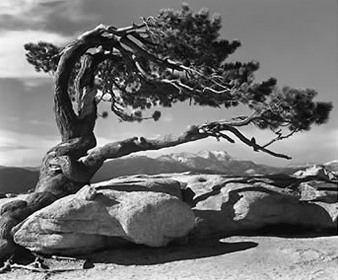
Thursday, May 28, 2009
Thursday, May 21, 2009
Thursday, May 14, 2009
Wednesday, May 13, 2009
Edward Weston
1. Edward Weston began taking photographs when he was sixteen. He received his first camera and took photos of Chicago parks and his aunt's farm. One year later, the Chicago Art Institute put his photographs up for exhibit. He then enrolled in the Illinois College of Photography. In 1906, Edward Weston moved to California and opened his first photographic studio. He also wrote articles about his unique style of photo taking for many big-name magazines. Weston kept taking photographs of nature, landscapes, plants, and nudes. Unfortunately, Weston died of Parkinson's Disease in 1958.
2. Weston's photographic style consisted of using an 8"x10" view camera. His style changed from pictorialism to straight photography (including humans and nature) in the middle of his career. Some of his most famous photos include "Pepper #30", "Dunes, Oceano", and "Nude, 1936".

2. Weston's photographic style consisted of using an 8"x10" view camera. His style changed from pictorialism to straight photography (including humans and nature) in the middle of his career. Some of his most famous photos include "Pepper #30", "Dunes, Oceano", and "Nude, 1936".

Ansel Adams
1. Ansel Adams was an excellent black and white photographer. In 1921, his Yosemite photographs were first published. Instead of becoming a musician, Adams decided to become a professional photographer. He strayed away from hand-coloring, which was extremely popular at the time. Adams used different lenses to vary his results. Ansel Adams signed a contract for his first portfolio in 1927. This portfolio turned out to be a success, earning him around $4000, and leading him to objectives such as taking pictures of the supporters who bought his pieces of art. Adams later put up his first solo photo exhibit at the Smithsonian Institution in 1931. In 1933, Adams opened his first photo gallery in San Francisco, CA. He published essays for magazines relevant to photography and wrote an instructional book called Making a Photograph. Ever since then until 1984, Ansel Adams continued to produce photographs and put on exhibits.
2. Adams had a unique photographic style. In his photographs, he used what is known is as the "zone system", which was a way to determine the right amount of exposure and adjust the contrast of the final piece. He used large-format view cameras, which helped sharpen his photos. Ansel Adams loved to take pictures of outdoor features and landmarks. such as the Half Dome, Mt. Williamson, New Mexico, and the Sierra. Some of his most famous photographs include Monlith, Rose and Driftwood, Yosemite Valley, Clearing Winter Storm, Ice on Ellery Lake, New Mexico, and Aspens, New Mexico.
3. My favorite Ansel Adams photograph is:

2. Adams had a unique photographic style. In his photographs, he used what is known is as the "zone system", which was a way to determine the right amount of exposure and adjust the contrast of the final piece. He used large-format view cameras, which helped sharpen his photos. Ansel Adams loved to take pictures of outdoor features and landmarks. such as the Half Dome, Mt. Williamson, New Mexico, and the Sierra. Some of his most famous photographs include Monlith, Rose and Driftwood, Yosemite Valley, Clearing Winter Storm, Ice on Ellery Lake, New Mexico, and Aspens, New Mexico.
3. My favorite Ansel Adams photograph is:

Wednesday, May 6, 2009
1. In your words write a short bio of his photographic experience.
2. Who are some of the famous people or things he has photographed?
Campbells Soup, Marilyn Monroe, Coca-Cola, Troy Donahue, Elizabeth Taylor
3.Post your favorite Warhol image to your blog.
- What are the three basic elements of a camera? The lens, the film, and the camera body
- What is an SLR camera? A camera where the photographer can see the exact image that is on the film and can adjust everything by turning buttons.
- What is the purpose of a camera's aperture? The camera's aperture is the amount of light let into the camera and onto the picture. A smaller aperture lets in less light while a larger aperture lets in more light.
- What does shutter speed on a camera control? The shutter speed controls how much light is let into the camera.
- To get the right exposure for a picture, what three things must be balanced? film speed, aperture size, shutter speed
- To take pictures outside on a very sunny day, would you use a high or low film speed? Why? Low speed film because they are optimal for brighter shots.
- What are the four steps for developing black and white film?
-the film is placed in developing agent
-rinsing film with water, or using "stop" bath
-fixing bath. The fixer dissolves only silver-halide crystals, leaving the silver metal behind.
-film is washed with water to remove all the processing chemicals. - What things are needed to make a black and white print?
-enlarger
-black-and-white paper - For a black and white print, the final image is actually what material?
silver
Subscribe to:
Posts (Atom)










